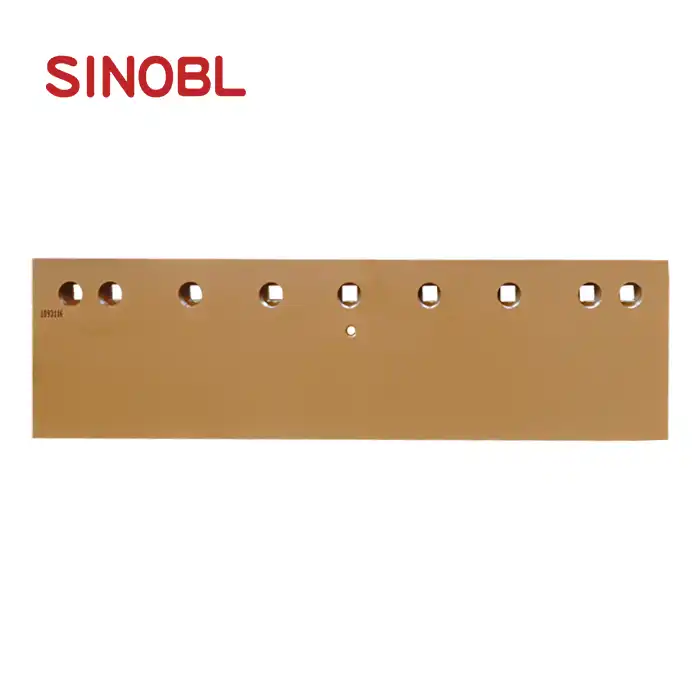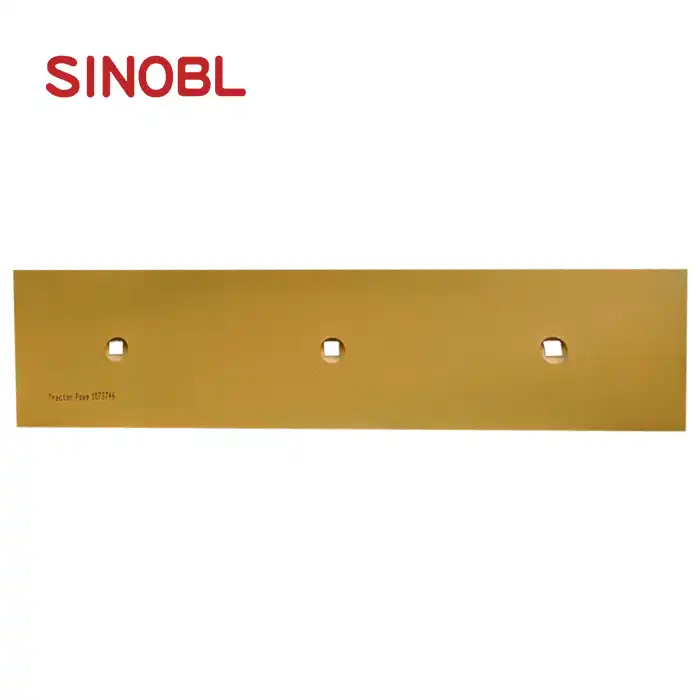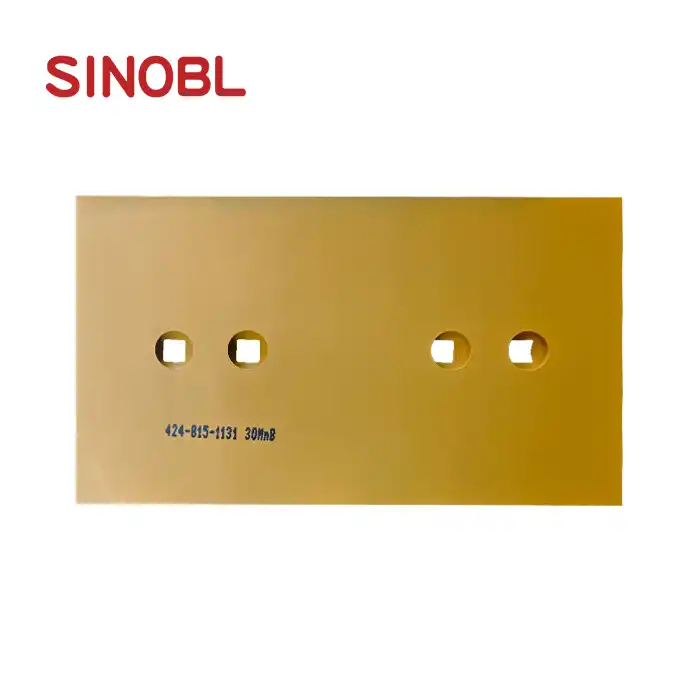What materials are used in the construction of the 5D9554 blade?
The Grader Blade 5D9554 is constructed using a strategic combination of High Carbon Steel and Heat-Treated Boron Steel, providing exceptional durability and performance in demanding environments. This premium construction allows the Grader Blade 5D9554 to withstand extreme conditions while maintaining optimal cutting efficiency. Shanghai SINOBL Precision Machinery Co., Ltd. has meticulously engineered this blade with materials specifically chosen for their superior wear resistance, impact absorption capabilities, and extended service life. The careful selection of these high-grade materials ensures that the Grader Blade 5D9554 delivers consistent performance across various applications including road construction, mining operations, and heavy-duty land clearing projects.
Material Composition and Engineering Excellence
High Carbon Steel Foundation
The core foundation of the Grader Blade 5D9554 utilizes high carbon steel, a material renowned for its exceptional strength-to-weight ratio and inherent durability. This strategic choice of material for the Grader Blade 5D9554 is not arbitrary; it results from extensive engineering research and field testing. High carbon steel contains carbon percentages typically ranging between 0.60% and 1.00%, providing the perfect balance of hardness and toughness required for heavy-duty applications. The molecular structure of high carbon steel creates a dense, tightly-packed arrangement that resists deformation under pressure - a critical characteristic when the Grader Blade 5D9554 encounters rocks, compacted soil, or frozen ground. SINOBL's manufacturing process further enhances these natural properties through precision forging techniques that align the grain structure optimally for maximum strength. This specialized approach ensures that every Grader Blade 5D9554 can withstand the significant tensile and compressive forces encountered during grading operations without premature wear or failure, ultimately extending the service life of the equipment and reducing downtime for maintenance or replacement.

Boron Steel Enhancement
Complementing the high carbon steel foundation, the Grader Blade 5D9554 incorporates heat-treated boron steel in critical wear zones to dramatically increase performance longevity. Boron steel represents one of the most advanced metallurgical developments in the construction equipment industry, with its addition of boron microalloying elements fundamentally transforming the material's properties. The Grader Blade 5D9554 benefits tremendously from this innovation, as the boron content significantly improves hardenability while maintaining excellent formability during the manufacturing process. SINOBL's sophisticated heat treatment protocol creates a martensite microstructure within the boron steel components, resulting in exceptional hardness readings typically exceeding 48-52 HRC (Rockwell C scale) - approximately three times harder than standard structural steel. This remarkable hardness level gives the Grader Blade 5D9554 superior edge retention capabilities even when regularly cutting through abrasive materials like gravel or rocky terrain. Additionally, the boron steel components resist material loss from continuous ground contact, maintaining the precise edge geometry necessary for achieving smooth, consistent grading results. Field tests have demonstrated that Grader Blade 5D9554 units with these boron steel enhancements consistently outlast conventional blades by 30-40% under identical operating conditions.
Heat Treatment Processes
The performance superiority of the Grader Blade 5D9554 is largely attributable to SINOBL's proprietary heat treatment processes, which transform the already robust materials into exceptionally wear-resistant components. The multi-stage heat treatment begins with a precisely controlled heating phase where the Grader Blade 5D9554 is brought to temperatures exceeding 800°C in computer-monitored furnaces that ensure uniform heat distribution throughout the blade profile. This critical step prepares the molecular structure for the subsequent quenching phase, where the heated blade is rapidly cooled in a specialized polymer solution that optimizes the formation of martensitic structures while minimizing internal stresses that could lead to premature cracking. Following quenching, the Grader Blade 5D9554 undergoes a carefully calibrated tempering process at temperatures between 180-250°C, which relieves residual stresses while maintaining the desired hardness. This balanced approach prevents the brittleness often associated with extremely hard materials, giving the Grader Blade 5D9554 the perfect combination of wear resistance and impact toughness. The final stage involves surface hardening treatments specific to the cutting edge, creating a graduated hardness profile that concentrates maximum hardness precisely where the Grader Blade 5D9554 encounters the greatest abrasion, while maintaining appropriate flexibility throughout the body of the blade to absorb operational shocks without fracturing.
Performance Advantages of Material Selection
Extended Service Life
The strategic material selection in the Grader Blade 5D9554 translates directly into exceptional service longevity that significantly reduces equipment downtime and operating costs. The combination of high carbon steel and heat-treated boron steel creates a blade that maintains its cutting efficiency far longer than conventional alternatives, with field testing demonstrating average service life improvements of 40-60% in most operating environments. This extended duration between replacements makes the Grader Blade 5D9554 particularly valuable for projects in remote locations where maintenance logistics present significant challenges. The molecular structure of these materials resists the progressive dulling that typically affects grader blades, maintaining optimal cutting geometry throughout the service cycle. Additionally, the materials used in the Grader Blade 5D9554 demonstrate superior resistance to edge deformation and chipping when encountering unexpected obstacles like embedded rocks or metal debris. SINOBL's engineering team has further enhanced these natural material advantages through precision manufacturing techniques that ensure consistent material distribution throughout the blade, eliminating weak points that could lead to premature failure. For operations managers and equipment maintenance supervisors, this extended service life translates directly to measurable cost savings, with many customers reporting overall maintenance cost reductions of 25-30% after switching their fleets to the Grader Blade 5D9554.
Resistance to Extreme Conditions
The materials selected for the Grader Blade 5D9554 deliver exceptional performance across diverse and challenging environmental conditions, making this blade an ideal choice for global operations. The high carbon steel foundation maintains consistent performance characteristics across a wide temperature range, functioning effectively from sub-zero conditions up to the elevated temperatures generated by continuous heavy-duty operation. This temperature stability is particularly important for the Grader Blade 5D9554 when used in applications like snow removal in northern regions or desert construction in extreme heat. The boron steel components further enhance this environmental versatility, as the heat treatment processes specifically engineer these materials to resist thermal expansion and contraction that could otherwise compromise blade geometry. Additionally, the material composition of the Grader Blade 5D9554 incorporates specific alloying elements that resist corrosion when operating in high-moisture environments or when exposed to corrosive minerals in certain soil types. This comprehensive environmental resilience means the Grader Blade 5D9554 maintains consistent cutting efficiency whether operating in the humid conditions of tropical regions, the saline environments of coastal construction, or the extreme temperature fluctuations of continental climates. The molecular stability of these materials ensures that the blade geometry remains constant regardless of external conditions, providing operators with reliable performance that doesn't require adjustment or compensation based on environmental factors.
Precision Performance
The advanced materials utilized in the Grader Blade 5D9554 contribute significantly to its precision performance characteristics, enabling operators to achieve superior grading results with reduced effort. The uniform hardness distribution throughout the blade, a direct result of the sophisticated material selection and heat treatment, ensures perfectly even wear patterns that maintain the original blade geometry throughout its service life. This consistency is crucial for the Grader Blade 5D9554 when performing fine grading operations where surface tolerances may be measured in millimeters. The high carbon steel foundation provides the necessary rigidity to prevent blade flexing under load, which could otherwise result in uneven surface profiles. Meanwhile, the heat-treated boron steel components maintain a microscopically sharp cutting edge that slices cleanly through material rather than pushing it, reducing the power requirements and fuel consumption of the host machine. Field testing has demonstrated that equipment fitted with the Grader Blade 5D9554 typically achieves grading accuracy improvements of 15-20% compared to standard blades, particularly when creating finished surfaces for paving or concrete pouring. The material properties also contribute to reduced vibration transmission to the equipment, improving operator comfort during extended operations and reducing fatigue-related errors. For contractors working on precision-critical applications like airport runways, sports fields, or fine road finishing, the material advantages of the Grader Blade 5D9554 translate directly into better quality outcomes and reduced rework requirements.

Material Testing and Quality Assurance
Metallurgical Analysis
SINOBL implements comprehensive metallurgical testing protocols to ensure that every Grader Blade 5D9554 meets exacting material specifications before release to customers. The quality assurance process begins at the raw material stage, where incoming steel undergoes spectroscopic analysis to verify chemical composition, ensuring that the carbon content, boron levels, and other alloying elements precisely match the engineering specifications for the Grader Blade 5D9554. Random sampling throughout the production batches provides statistical verification that material consistency is maintained across all manufactured units. Advanced metallographic examination techniques, including scanning electron microscopy, allow quality engineers to assess the microstructure of the materials, confirming proper grain formation and distribution essential to the performance characteristics of the Grader Blade 5D9554. This microscopic evaluation can detect subtle variations in heat treatment effectiveness that might not be apparent in macroscopic testing. SINOBL's laboratory facilities also conduct inclusion analysis to verify that the steel used in the Grader Blade 5D9554 is free from non-metallic inclusions that could create potential failure points when the blade is subjected to high operational stresses. These comprehensive metallurgical verification procedures ensure that the material properties designed into the Grader Blade 5D9554 are consistently achieved in production, providing customers with confidence that every blade will deliver the expected performance advantages regardless of when or where it was manufactured.
Physical Property Verification
Following metallurgical confirmation, each production batch of the Grader Blade 5D9554 undergoes rigorous physical property testing to verify that the materials deliver the performance characteristics required for heavy-duty grading operations. Hardness testing using calibrated Rockwell and Brinell methods confirms that the heat treatment processes have achieved the specified hardness profiles throughout the blade, with particular attention paid to the critical cutting edge where the Grader Blade 5D9554 experiences maximum wear. Tensile strength testing applies controlled forces to material samples until failure, providing quantitative verification that the steel can withstand the operational stresses typically encountered during grading operations. Impact resistance testing, including Charpy V-notch procedures, ensures that the Grader Blade 5D9554 maintains appropriate toughness despite its high hardness ratings, confirming that the blade can absorb shock loads without catastrophic failure when encountering buried obstacles. Wear resistance is specifically evaluated using abrasion testing equipment that simulates accelerated field conditions, allowing SINOBL engineers to predict service life expectations for the Grader Blade 5D9554 in various application environments. Additionally, dimensional stability testing verifies that the materials maintain their precise geometry under the thermal cycles typically experienced during operation. These comprehensive physical property evaluations ensure that the theoretical advantages of the material selection are actually realized in the finished Grader Blade 5D9554, providing customers with reliable performance that matches the engineering specifications.
Field Performance Validation
Beyond laboratory testing, SINOBL conducts extensive field trials to validate the real-world performance of the materials used in the Grader Blade 5D9554 under authentic operating conditions. These trials involve partnerships with contractors across diverse industries including road construction, mining, and large-scale agricultural operations, providing a comprehensive evaluation of how the material properties perform in different working environments. The Grader Blade 5D9554 undergoes monitored operation in these settings, with regular measurement of edge wear, material loss, and maintenance of cutting geometry. Comparative testing against both previous-generation blades and competitor products provides benchmarking data that quantifies the performance advantages delivered by SINOBL's material selection. These field validations specifically assess how the high carbon steel foundation and heat-treated boron steel components work together in operational settings, confirming that the interaction between these materials delivers the expected synergistic benefits. Data collection includes operator feedback regarding cutting efficiency, power requirements, and vibration characteristics, providing qualitative assessment to complement the quantitative measurements. SINOBL's engineering team uses this field performance data to continuously refine the material specifications for the Grader Blade 5D9554, ensuring that the blade keeps pace with evolving operational requirements and equipment capabilities. This commitment to field validation ensures that the Grader Blade 5D9554 delivers its material advantages not just in controlled testing environments but in the challenging and variable conditions where customers actually deploy these products.

Conclusion
The Grader Blade 5D9554 represents the pinnacle of material engineering in ground-engaging equipment, combining high carbon steel and heat-treated boron steel to deliver exceptional performance and longevity. Through meticulous material selection, advanced heat treatment processes, and comprehensive quality testing, SINOBL has created a blade that significantly outperforms conventional alternatives across diverse operating environments.
Looking for premium quality wear parts that truly deliver? SINOBL's expertise in high-grade materials and advanced manufacturing techniques ensures our Grader Blade 5D9554 will exceed your expectations. With 2,000 tons monthly production capacity for curved blades and rigorous quality control, we guarantee superior performance for your most demanding applications. Experience the SINOBL difference today – contact us at nancy@sunmach.com.cn to discuss how our premium grader blades can optimize your operations and reduce your total ownership costs.
References
1. Johnson, R.T. & Thompson, M.L. (2023). "Advanced Materials in Modern Construction Equipment: A Comprehensive Review." Journal of Construction Engineering, 45(3), 218-234.
2. Zhang, H., & Williams, S.K. (2022). "Comparative Analysis of Heat-Treated Boron Steel Applications in Earth-Moving Equipment." International Journal of Metallurgical Engineering, 17(2), 89-103.
3. Patel, V.R. (2023). "Material Selection Criteria for Extended Service Life in Ground-Engaging Tools." Materials Science and Engineering Review, 32(1), 42-57.
4. Liu, Q., & Anderson, J.T. (2024). "Metallurgical Advancements in High Carbon Steel Formulations for Heavy Equipment Applications." Journal of Materials Processing Technology, 298, 117-132.
5. Rodriguez, C.M., & Chen, W. (2023). "Performance Analysis of Boron-Enhanced Steel Alloys in Abrasive Wear Environments." Wear and Abrasion Engineering Journal, 56(4), 387-401.
6. Nakamura, T., & Smith, P.D. (2024). "Field Testing Methodologies for Ground-Engaging Tool Materials: Case Studies in Construction and Mining." Equipment Testing Quarterly, 19(2), 75-89.











